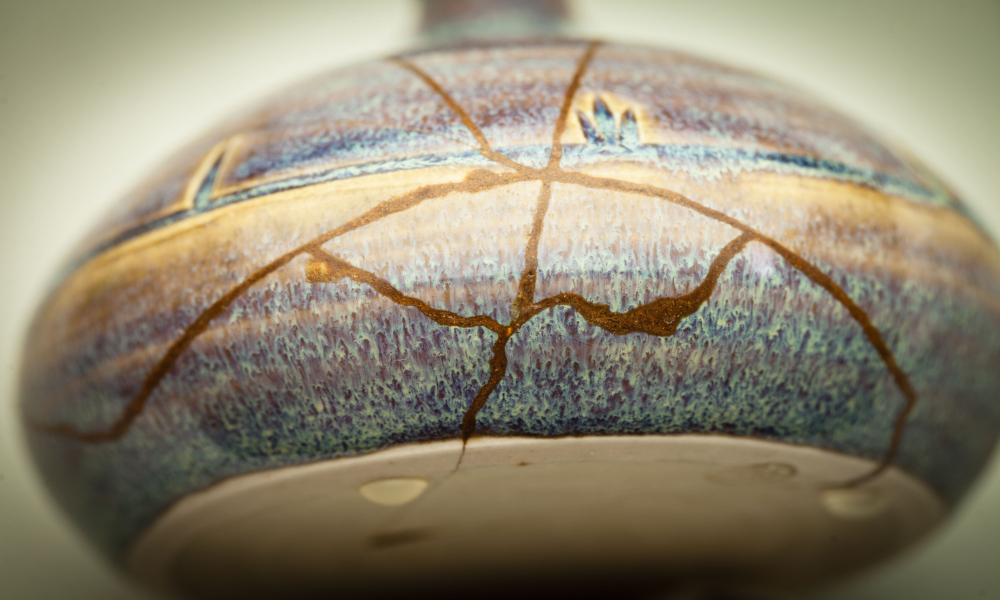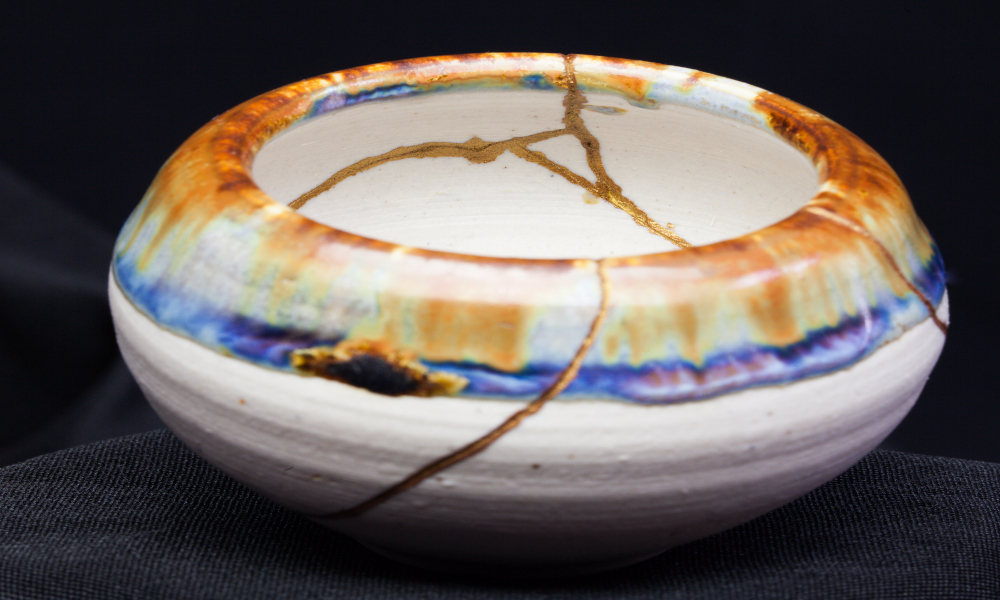“At the heart of Japanese philosophy and wisdom lies a concept called ‘wabi-sabi’; a term which denotes a commitment to the everyday, the melancholic, the somewhat broken and the imperfect. It’s a term we need a lot more of in our lives.” The school of life.
In Japanese ‘Kintsugi’ means to ‘join with gold’, an elegant and graceful way to mend broken pottery, leaving the mend fully visible and highlighting it with the precious metal. The pot shards are fused back together with gold, and the gilded cracks become part of the object’s beauty. The imperfection reveals a different loveliness, one where the imperfect is actually perfect.
Kintsugi also a world view that focuses on the acceptance of transience and the beauty of imperfection. Kintsugi makes no attempt to hide or disguise broken things. Imperfection is celebrated instead. And, so the belief goes, the end result is more beautiful because it has been broken, and stronger because of the breaks.
Wabi-Sabi opens things up, applying much the same theory to the world as a whole, a Japanese philosophy celebrating the beauty of the naturally imperfect. Wabi means an understated elegance achieved via simple, natural, unpretentious design. Sabi means seeing real beauty in the flaws that come with age.
Together, Wabi-sabi and kintsugi form a world view that we can all learn from, showing us that imperfections can be turned to gold. Do you see the beauty in the imperfect, the impermanent, and the incomplete?

The British version of Wabi-sabi and Kintsugi
We do it too, in our own way. The past ten years has seen a powerful trend towards making do and mending, recycling, re-using, and re-purposing. We’ve been appreciating the beauty of the patina on old pieces of furniture, turning scrap into sculpture, enjoying industrial-style interior décor with all its well-used imperfections.
While the things we do aren’t often as elegant and graceful as the Japanese way, we too have come to appreciate the beauty of the used up and worn out. So much so that it has become extremely fashionable. In a way, what began as an interior design trend has become a new way of looking at life, and the challenges of the times we all live in now has thrown everything into high relief.
How to handle the broken bits of our selves

Both of these ancient Japanese traditions, these different ways of looking at life, tell us a lot about how to deal with the parts of our selves we feel are broken. Now more than ever we realise how messy and difficult life is. It isn’t often smooth, perfect and unbroken. In fact, isn’t smooth and unbroken a little bit boring when you think about it? Now’s the perfect time to appreciate life’s imperfections. This is an excellent time to learn, and mend, and build your resilience, rather than expect the impossible from yourself and others in times when there’s so much change, so much complexity, so many unknowns.
This is your chance to become more compassionate, first towards yourself, then towards others. It’s time to sew some kindness into the places where there’s brokenness. Time to bring broken pieces together and celebrate the mend openly, because that break has brought change, and the repair you’ve made in response to the break is beautiful.
We can’t say it better than Elisabeth Kübler-Ross and Brene Brown.
As Kübler-Ross says, “The most beautiful people we have known are those who have known defeat, known suffering, known struggle, known loss, and have found their way out of the depths. These persons have an appreciation, a sensitivity, and an understanding of life that fills them with compassion, gentleness, and a deep loving concern. Beautiful people do not just happen.”
And as Brown says, “Imperfections are not inadequacies; they are reminders that we’re all in this together.”
Watch Kintsugu in action
About us:
We create the space for leaders to step back, think clearly, and navigate complexity with confidence. By sharpening the narrative that drives decisions, teams, and performance, we help leaders move forward with clarity and impact. Our approach blends deep listening, incisive challenge, and commercial focus—strengthening leadership at every level, from business transformation to boardroom decisions.
“We share resources that help coaches deepen their practice and expand their impact. The articles on this site are designed to spark fresh thinking, offer practical tools, and support the continuous growth of coaches at every stage. “
Jude Elliman
Founder
Our Core Approach:
We work with leaders to sharpen their thinking, strengthen their leadership, and navigate complexity with confidence. Our approach is built around three core areas:
Narrative Coaching – Working with the stories that shape leadership, teams, and organisations.
Commercial Focus – Cutting through complexity to drive clear, strategic decisions.
Challenge & Space – Asking the right questions while creating the space to reflect and grow.
Through this, we help leaders drive transformation, align teams, and make high-stakes decisions with clarity and impact.
